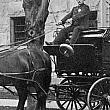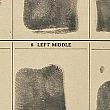
Doomed Police Building Houses a Colorful Past
If it’s true that old buildings absorb the personalities of the people who occupied them, then Grand Rapids Police Headquarters has richness in its bones.
Through these high-ceilinged grimy halls and up and down the angular and ornate central stairway and in that forbidding section referred to by policemen since 1914 as the “southeast corner”—all soon to fall to the wrecking crews—have walked and worked some memorable human beings.
Harvey O. Carr was police chief when the building was new in 1892, a man who was appointed chief despite his having worked the previous years as a printer for 20 years, and who freely admitted he knew nothing of police affairs and hadn’t give a day’s attention to law enforcement in his life.
Carr worked all day at his desk and then walked the beats most of the night with his patrolmen to learn the business. He went on to serve more than 21 years as one of the city’s great superintendents of police.
Perhaps only a few old policemen or city politicians remember Dr. Gustav A. Blumenthal, but the memory would be vivid. Blumenthal was a phrenologist and psychiatrist of some renown and he was hired in 1928 to interview young policemen, finger their skulls, and pick out the bad ones.
Unfortunately, vocational analysis would not have its vogue for another 20 or 30 years, and Blumenthal was not understood, least of all by the policemen. His $4000 bill for services was a shocker and produced a City Hall donnybrook which helped blow out of office the city’s first and last public safety director, James Sinke.
Albert A. Carroll, crusty, colorful and eminently qualified gave the building’s southeast corner its special quality. In fact, “Ab” Carroll, who was chief of police from 1914 to 1936, was often referred to by the officers not as Chief Carroll but simply as “southeast corner.” This was and is the office of the superintendent of police. The policeman summoned to that room in Carroll’s day, whatever the reason, never forgot the experience.
One of Carroll’s appointments in 1922 to the detective bureau was Walter Coe, first Negro to be employed by the department and a captain of detectives when he died at his desk 35 years later. A solid investigator, witty and courageous, and also one of the best semi-professional baseball players of his day, Coe’s is the memory most likely to outlive the building.
“The Deacon,” whose spats and fancy vests brightened the old headquarters building when he was young operated the “Special Investigation” division of the detective bureau in an office on the third floor now used by the area contingent of Military Police.
Entered into folklore are stories of such men as Alton Warner, an early police radio man, who played recorded music and did amazingly accurate imitations of department personalities to entertain, amuse and exasperate the boys of patrol.
There was Herman Rhode with the German Accent, a patrolman from 1917 to 1943, who perpetrated a number of outrages against the established order, including one busy morning jerking all the plugs on the department switchboard where he was substituting and then addressing the winking, blinking, buzzing board—as if speaking to the world in general—“now ve schtart ofer.”
Thousands of criminals have walked these halls, sat in these offices, been locked in dank and cheerless “A” Block or “B” Block in the first floor detention area.
Here was brought the “Tuxedo Kid” who wore fancy evening dress when he pulled stick-ups in the 1920s.
Here came Alex Jeronis, the safe cracker extraordinary; Catherine R. Tate, convicted female bandit who escaped in 1952 from the Detroit House of Correction and who last was heard from allegedly living as a “model wife and mother” in Illinois where the governor refused to extradite her.
Here was brought Robert Mulford on a charge of non-support, whose trembling and shaking while being fingerprinted led to his interrogation and subsequent conviction of a brutal murder two years earlier of a 10 year old girl.
The stories of hard-luck and hard-living behind the hundreds of sets of initials carved into the paint of the steel walls of the lock-ups are endless.
So are the memories of 72 years of municipal law enforcement. Much of their substance will return to everlasting dust when the old headquarters building goes down.
Grand Rapids Press, November 2, 1964

 facebook
facebook




